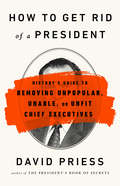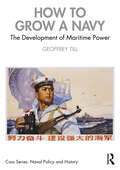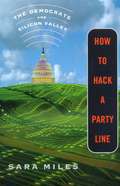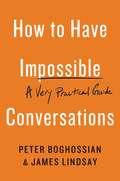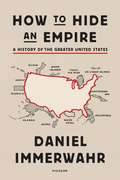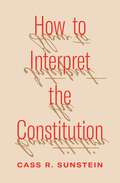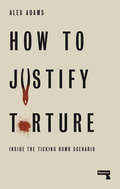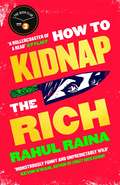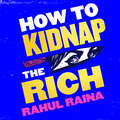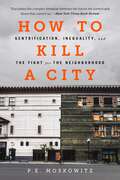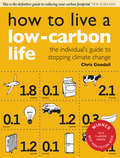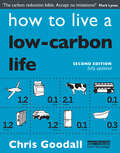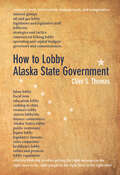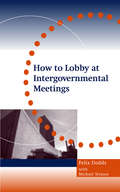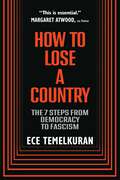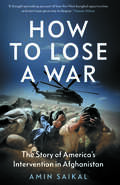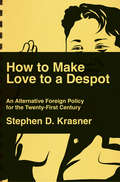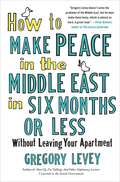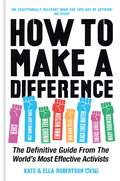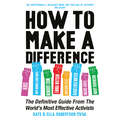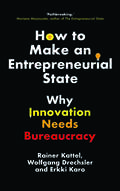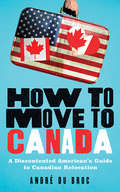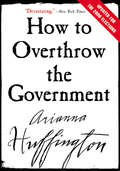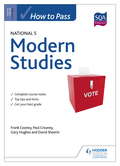- Table View
- List View
How to Get Rid of a President: History's Guide to Removing Unpopular, Unable, or Unfit Chief Executives
by David PriessA vivid political history of the schemes, plots, maneuvers, and conspiracies that have attempted--successfully and not--to remove unwanted presidentsTo limit executive power, the founding fathers created fixed presidential terms of four years, giving voters regular opportunities to remove their leaders. Even so, Americans have often resorted to more dramatic paths to disempower the chief executive. The American presidency has seen it all, from rejecting a sitting president's renomination bid and undermining their authority in office to the more drastic methods of impeachment, and, most brutal of all, assassination.How to Get Rid of a President showcases the political dark arts in action: a stew of election dramas, national tragedies, and presidential departures mixed with party intrigue, personal betrayal, and backroom shenanigans. This briskly paced, darkly humorous voyage proves that while the pomp and circumstance of presidential elections might draw more attention, the way that presidents are removed teaches us much more about our political order.
How to Grow a Navy: The Development of Maritime Power (Cass Series: Naval Policy and History)
by Geoffrey TillThis book examines the large but neglected topic of the development of maritime power from both an historical and a contemporary point of view. Navies have never been more important than they are now, in a century becoming, as widely expected, increasingly and profoundly maritime. The growing competition between China and Russia with the United States and its allies and partners around the world is essentially sea-based. The sea is also central to the world's globalised trading system and to its environmental health. Most current crises are either sea-based or have a critical maritime element to them. What happens at sea will help shape our future. Against that background, this book uses both history and contemporary events to analyse how maritime power and naval strength has been, and is being, developed. In a reader-friendly way, it seeks to show what has worked and what has not, and to uncover the recurring patterns in maritime and naval development which explain past, present and future success - and failure. It reflects on the historical experience of all navies, but in particular it poses the question of whether China is following the same pattern of naval development illustrated by Britain at the start of the 18th century, which led to two centuries of naval dominance. This book will be of much interest to students of maritime power, naval studies, and strategic studies, as well as to naval professionals around the world.
How to Hack a Party Line
by Sara MilesThe gripping story of the emergence of a powerful new force in American politicsSara Miles's How to Hack the Party Line is the first book to explain the political significance of the high-technology industry, and to show the birth of a relationship between the new millionaires of the Information Age and power-hungry Washington insiders that will shape the politics of the twenty-first century.Packed with exclusive, behind-the-scenes reporting, How to Hack a Party Line chronicles a high-stakes experiment: the creation of Silicon Valley's first political machine. The book explores the often contradictory forces behind Silicon Valley's political awakening -- a mixture of naive libertarian sentiment, northern California social attitudes, aggressive business instincts, and a raw desire for power. Simultaneously it looks at centrist "new Democrats" who have left behind the labor coalitions of the industrial economy and are seeking a new identity in the values proclaimed by high-tech capitalists: growth, globalism, efficiency, and innovation.How to Hack the Party Line combines a colorful, character-rich narrative with serious reporting and political analysis. It asks what values prosper when high-tech business becomes the metaphor for society? And how, in the twenty-first century, will democracy respond?
How to Have Impossible Conversations: A Very Practical Guide
by Peter Boghossian James Lindsay"This is a self-help book on how to argue effectively, conciliate, and gently persuade. The authors admit to getting it wrong in their own past conversations. One by one, I recognize the same mistakes in me. The world would be a better place if everyone read this book." -- Richard Dawkins, author of Science in the Soul and Outgrowing GodIn our current political climate, it seems impossible to have a reasonable conversation with anyone who has a different opinion. Whether you're online, in a classroom, an office, a town hall -- or just hoping to get through a family dinner with a stubborn relative -- dialogue shuts down when perspectives clash. Heated debates often lead to insults and shaming, blocking any possibility of productive discourse. Everyone seems to be on a hair trigger.In How to Have Impossible Conversations, Peter Boghossian and James Lindsay guide you through the straightforward, practical, conversational techniques necessary for every successful conversation -- whether the issue is climate change, religious faith, gender identity, race, poverty, immigration, or gun control. Boghossian and Lindsay teach the subtle art of instilling doubts and opening minds. They cover everything from learning the fundamentals for good conversations to achieving expert-level techniques to deal with hardliners and extremists. This book is the manual everyone needs to foster a climate of civility, connection, and empathy.
How to Hide an Empire: A History of the Greater United States
by Daniel ImmerwahrA pathbreaking history of the United States’ overseas possessions and the true meaning of its empireWe are familiar with maps that outline all fifty states. And we are also familiar with the idea that the United States is an “empire,” exercising power around the world. But what about the actual territories—the islands, atolls, and archipelagos—this country has governed and inhabited?In How to Hide an Empire, Daniel Immerwahr tells the fascinating story of the United States outside the United States. In crackling, fast-paced prose, he reveals forgotten episodes that cast American history in a new light. We travel to the Guano Islands, where prospectors collected one of the nineteenth century’s most valuable commodities, and the Philippines, site of the most destructive event on U.S. soil. In Puerto Rico, Immerwahr shows how U.S. doctors conducted grisly experiments they would never have conducted on the mainland and charts the emergence of independence fighters who would shoot up the U.S. Congress.In the years after World War II, Immerwahr notes, the United States moved away from colonialism. Instead, it put innovations in electronics, transportation, and culture to use, devising a new sort of influence that did not require the control of colonies. Rich with absorbing vignettes, full of surprises, and driven by an original conception of what empire and globalization mean today, How to Hide an Empire is a major and compulsively readable work of history.
How to Interpret the Constitution
by Cass R. SunsteinFrom New York Times bestselling author Cass Sunstein, a timely and powerful argument for rethinking how the U.S. Constitution is interpretedThe U.S. Supreme Court has eliminated the right to abortion and is revisiting other fundamental questions today—about voting rights, affirmative action, gun laws, and much more. Once-arcane theories of constitutional interpretation are profoundly affecting the lives of all Americans. In this brief and urgent book, Harvard Law School professor Cass Sunstein provides a lively introduction to competing approaches to interpreting the Constitution—and argues that the only way to choose one is to ask whether it would change American life for the better or worse. If a method of interpretation would eliminate the right of privacy, allow racial segregation, or obliterate free speech, it would be unacceptable for that reason.But some Supreme Court justices are committed to “originalism,” arguing that the meaning of the Constitution is settled by how it was publicly understood when it was ratified. Originalists insist that their approach is dictated by the Constitution. That, Sunstein argues, is a big mistake. The Constitution doesn’t contain instructions for its own interpretation. Any approach to constitutional interpretation needs to be defended in terms of its broad effects—what it does to our rights and our institutions. It must respect those rights and institutions—and safeguard the conditions for democracy itself.Passionate and compelling, How to Interpret the Constitution is essential reading for anyone who is concerned about how the Supreme Court is changing the rights and lives of Americans today.
How to Justify Torture: Inside the Ticking Bomb Scenario
by Alex AdamsFrom Batman Begins to Tom Clancy, How to Justify Torture shows how contemporary culture creates simplified narratives about good guy torturers and bad guy victims, how dangerous this is politically, and what we can do to challenge it.If there was a bomb hidden somewhere in a major city, and you had the person responsible in your custody, would you torture them to get the information needed to stop the bomb exploding, preventing a devastating terrorist attack and saving thousands of lives?This is the ticking bomb scenario -- a thought experiment designed to demonstrate that torture can be justified.In How to Justify Torture, cultural critic Alex Adams examines the ticking bomb scenario in-depth, looking at the ways it is presented in films, novels, and TV shows -- from Batman Begins and Dirty Harry to French military thrillers and home invasion narratives. By critiquing its argument step by step, this short, provocative book reminds us that, despite what the ticking bomb scenario will have us believe, torture can never be justified.
How to Kidnap the Rich: 'A joyous love/hate letter to contemporary Delhi' The Times
by Rahul Raina'This is an absolute riot - part thriller, part satire of contemporary urban India' Mail on Sunday'If you're fat and Indian, you're rich; if you're fat and poor, you're lying. It's only the West where the rich are thin and vegan and moral...Ramesh Kumar grew up deprived and unloved, working on his father's tea stall in the Old City of Delhi. Now, brilliant but poor, he makes a lucrative living taking tests for the sons of India's elite. When one of his clients, the sweet but hapless eighteen-year-old Rudi Saxena, places first in the All Indias, the national university entrance exams, Ramesh sees an unmissable opportunity.Cashing in on Rudi's newfound celebrity, all goes well for both boys for a while. But Rudi's role on a game show leads to unexpected love, blackmail and, finally, a dangerous kidnapping.As Ramesh leads Rudi through a maze of crimes both large and small, their dizzying journey reveals an India in all its complexity, beauty, and squalor, moving from the bottom rungs to the circles inhabited by the ultra-rich and everywhere in between.Praise for How to Kidnap the Rich'A satire on modern India...this isn't a story about poverty, it's a story about wealth' Guardian'Conjures up a memorable world that is ghee-greased, polluted, mired in dust and corruption' Sunday Times'Like Mohsin Hamid's How to Get Filthy Rich in Rising Asia, How to Kidnap the Rich purports to be a how-to manual but is in fact a rollicking urban adventure and a biting satire of inequality' Economist
How to Kidnap the Rich: 'A joyous love/hate letter to contemporary Delhi' The Times
by Rahul Raina'Ramesh is a wonderfully vivid character and this is an explosively funny, surprisingly moving debut''Mail on SundayIf you're fat and Indian, you're rich; if you're fat and poor, you're lying. It's only the West where the rich are thin and vegan and moral...Ramesh Kumar grew up deprived and unloved, working on his father's tea stall in the Old City of Delhi. Now, brilliant but poor, he makes a lucrative living taking tests for the sons of India's elite. When one of his clients, the sweet but hapless eighteen-year-old Rudi Saxena, places first in the All Indias, the national university entrance exams, Ramesh sees an unmissable opportunity.Cashing in on Rudi's newfound celebrity, all goes well for both boys for a while. But Rudi's role on a game show leads to unexpected love, blackmail and, finally, a dangerous kidnapping.As Ramesh leads Rudi through a maze of crimes both large and small, their dizzying journey reveals an India in all its complexity, beauty, and squalor, moving from the bottom rungs to the circles inhabited by the ultra-rich and everywhere in between.Praise for How to Kidnap the Rich'A satire on modern India...this isn't a story about poverty, it's a story about wealth' Guardian'Conjures up a memorable world that is ghee-greased, polluted, mired in dust and corruption' Sunday Times'Like Mohsin Hamid's How to Get Filthy Rich in Rising Asia, How to Kidnap the Rich purports to be a how-to manual but is in fact a rollicking urban adventure and a biting satire of inequality' Economist
How to Kill a City: Gentrification, Inequality, and the Fight for the Neighborhood
by PE Moskowitz&“An exacting look at gentrification&” (New York Times Book Review)—and the lives devastated in the process The term gentrification has become a buzzword to describe the changes in urban neighborhoods across the country, but we don&’t realize just how threatening it is. It means more than the arrival of trendy shops, much-maligned hipsters, and expensive lattes. The very future of American cities as vibrant, equitable spaces hangs in the balance. P. E. Moskowitz&’s How to Kill a City takes readers from the kitchen tables of hurting families who can no longer afford their homes to the corporate boardrooms and political backrooms where destructive housing policies are devised. Along the way, Moskowitz uncovers the massive, systemic forces behind gentrification in New Orleans, Detroit, San Francisco, and New York. In the new preface, Moskowitz stresses just how little has changed in those same cities and how the problems of gentrification are proliferating throughout America. The deceptively simple question of who can and cannot afford to pay the rent goes to the heart of America&’s crises of race and inequality. A vigorous, hard-hitting exposé, How to Kill a City reveals who holds power in our cities and how we can get it back.
How to Land a Top-Paying Federal Job: Your Complete Guide to Opportunities, Internships, Resumes and Cover Letters, Networking, Interviews, Salaries, Promotions, and More!
by Lily WhitemanWritten by a successful career coach who herself has climbed the federal career ladder and served as a hiring manager, this indispensable book is the ultimate guide to securing a job in government work. How to Land a Top-Paying Federal Job steers federal applicants through every stage of their job search--from finding unadvertised openings and getting interviews to sealing enviable deals and even getting promoted. You&’ll gain insights from more than one hundred federal hiring managers, and learn the secrets to impressing these gatekeepers online, on paper, and in person.This updated second edition includes:more get-ahead tips,the latest hiring advice on writing winning applications,expanded directories for internships,listings of fast-track management training programs and fellowships,and information on emerging helpful websites and other resources.Complete with a companion CD filled with sample resumes, checklists, and templates, How to Land a Top-Paying Federal Job gives business professionals with big dreams of climbing the federal career ladder the inside scoop on landing some of the nation's most secure, well-paying, and rewarding jobs.
How to Live a Low-Carbon Life: The Individual's Guide to Stopping Climate Change
by Christopher GoodallClimate change is the greatest challenge facing humanity: drastic reduction of carbon emissions is vital if we are to avoid a catastrophe that devastates large parts of the world. Governments and businesses have been slow to act and individuals now need to take the lead. The Earth can absorb no more than 3 tonnes of carbon dioxide emissions each year for every person on the planet if we are to keep temperature and rainfall change within tolerable limits. Yet from cars and holiday flights to household appliances and the food on our plates, Western consumer lifestyles leave each of us responsible for over 12 tonnes of carbon dioxide a year - four times what the Earth can handle. Individual action is essential if we want to avoid climate chaos. How to Live a Low-Carbon Life shows how easy it is to take responsibility, providing the first comprehensive, one-stop reference guide to calculating your CO2 emissions and reducing them to a sustainable 3 tonnes a year.
How to Live a Low-Carbon Life: The Individual's Guide to Tackling Climate Change
by Chris GoodallDrastic reduction of carbon emissions is vital if we are to avoid a catastrophe that devastates large parts of the world. Governments and businesses have been slow to act - individuals need to take the lead now if we are to avoid climate chaos. Each Westener is responsible for an average 10 - 20 tonnes of carbon emissions each year (depending on where you live). In How to Live a Low-Carbon Life, Chris Goodall shows how easy it is to take responsibility, providing a comprehensive, one-stop reference guide to calculating your CO2 emissions and reducing them to a more sustainable 2 tonnes a year. This fully revised and expanded new edition takes into account new government targets on emissions reductions and includes up-to-date calculations and extensive graphics clearly laying out the path to a low-carbon life.
How to Lobby Alaska State Government
by Clive S. ThomasLobbying is about getting the right message to the right people in the right form at the right time. Even the most persuasive arguments or most influential groups will come up short if they aren’t combined with personal connections and an understanding of human nature. How to Lobby Alaska State Government is a guide to the essentials of organizing and implementing a lobbying campaign in Alaska that recognizes how you lobby is as important as who you lobby. This book starts by helping new lobbyists to think politically, by explaining the structure and operation of state government, the psychology and needs of public officials, and where the power lies in Juneau—who’s got political clout. How to Lobby then moves into the nitty-gritty of a lobbying campaign. It covers the basics of group influence, campaign planning and management, the pros and cons of various group tactics, tips on face-to-face meetings, and the challenges of lobbying day-to-day. In addition to extensive guidance on what to do, this book also emphasizes the things to avoid that will undermine or eliminate a lobbyist’s chances of success. Pragmatic and portable, this book will be valuable to new and professional lobbyists both, and anyone looking for fresh perspectives on this important business.
How to Lobby at Intergovernmental Meetings: Mine's A Caffe Latte
by Michael Strauss'Felix Dodds is the Milo Minderbinder of the stakeholder world!' Alex Kirby, BBC 'An invaluable tool for anyone wishing to understand and contribute effectively to the competition of good ideas that intergovernmental meetings should be' Paul Hohnen, former Strategic Director, Greenpeace International '...the book is a valuable resource for people willing to understand the practice of international negotiation and for those preparing to be influential negotiators.' Political Studies Review Organizations spend considerable resources taking staff to international meetings, often without understanding how these meetings work. This book is a unique guide on how to participate and be heard at intergovernmental meetings, whether as a stakeholder or a government official. It contains a wealth of essential reference material including tips for navigating the intergovernmental hot spots of New York and Geneva, lists of UN commissions, conferences and permanent missions, contact details of key international organizations, NGOs and stakeholder groups and useful web addresses. If you have never lobbied or just want to have a better understanding of how the intergovernmental governance process works, this book is the essential resource to make your work much easier.
How to Lose a Country: The 7 Steps from Democracy to Fascism
by Ece Temelkuran&“Essential.&” —Margaret Atwood An urgent call to action and a field guide to spotting the insidious patterns and mechanisms of the populist wave sweeping the globe from an award-winning journalist and acclaimed political thinker.How to Lose a Country is a warning to the world that populism and nationalism don&’t march fully-formed into government; they creep. Award-winning author and journalist Ece Temelkuran identifies the early warning signs of this phenomenon, sprouting up across the world from Eastern Europe to South America, in order to arm the reader with the tools to recognise it and take action. Weaving memoir, history and clear-sighted argument, Temelkuran proposes alternative answers to the pressing—and too often paralysing—political questions of our time. How to Lose a Country is an exploration of the insidious ideas at the core of these movements and an urgent, eloquent defence of democracy. This 2024 edition includes a new foreword by the author.
How to Lose a War: The Story of America's Intervention in Afghanistan
by Amin SaikalAn incisive, authoritative account of the West&’s failures in Afghanistan, from 9/11 to the fall of Kabul In 1958, Richard Nixon described Afghanistan as &“unconquerable.&” On 15 August 2021, he was proven right. After twenty years of intervention, US and NATO forces retreated, enabling the Taliban to return to power. Tens of thousands were killed in the long, unwinnable war, and millions more were displaced—leaving the future of Afghanistan hanging in the balance. Leading expert Amin Saikal traces the full story of America&’s intervention, from 9/11 to the present crisis. After an initial swift military strike, the US became embroiled in a drawn-out struggle to change Afghanistan but failed to achieve its aims. Saikal shows how this failure was underlined by protracted attempts to capture Osama bin Laden, an inability to secure a viable government via &“democracy promotion&” efforts, and lack of wider strategy in the &“war on terror.&” How to Lose a War offers an insightful account of one of the US&’s most significant foreign policy failures—and considers its dire consequences for the people of Afghanistan.
How to Make Love to a Despot: And Other Ways To Change American Foreign Policy In The Twenty-first Century
by Stephen D. KrasnerAfter generations of foreign policy failures, the United States can finally try to make the world safer—not by relying on utopian goals but by working pragmatically with nondemocracies. Since the end of the Second World War, the United States has sunk hundreds of billions of dollars into foreign economies in the hope that its investments would help remake the world in its own image—or, at the very least, make the world “safe for democracy.” So far, the returns have been disappointing, to say the least. Pushing for fair and free elections in undemocratic countries has added to the casualty count, rather than taken away from it, and trying to eliminate corruption entirely has precluded the elimination of some of the worst forms of corruption. In the Middle East, for example, post-9/11 interventionist campaigns in Afghanistan and Iraq have proved to be long, costly, and, worst of all, ineffective. Witnessing the failure of the utopian vision of a world full of market-oriented democracies, many observers, both on the right and the left, have begun to embrace a dystopian vision in which the United States can do nothing and save no one. Accordingly, calls to halt all assistance in undemocratic countries have grown louder. But, as Stephen D. Krasner explains, this cannot be an option: weak and poorly governed states pose a threat to our stability. In the era of nuclear weapons and biological warfare, ignoring troubled countries puts millions of American lives at risk. “The greatest challenge for the United States now,” Krasner writes, “is to identify a set of policies that lie between the utopian vision that all countries can be like the United States . . . and the dystopian view that nothing can be done.” He prescribes a pragmatic new course of policy. Drawing on decades of research, he makes the case for “good enough governance”—governance that aims for better security, better health, limited economic growth, and some protection of human rights. To this end, Krasner proposes working with despots to promote growth. In a world where a single terrorist can kill thousands or even hundreds of thousands of people, the United States does not have the luxury of idealistically ignoring the rest of the world. But it cannot remake the world in its own image either. Instead, it must learn how to make love to despots.
How to Make Peace in the Middle East in Six Months or Less Without Leaving Your Apartment
by Gregory LeveyHow to Make Peace in the Middle East is a fast-paced, unexpectedly humorous look at U.S. Middle East policy-making.
How to Make a Difference: The Definitive Guide from the World's Most Effective Activists
by Kate Robertson Ella Robertson"An exceptionally relevant book for this age of activism." Bob GeldofWith a foreword by Kofi Annan, former Secretary-General of the UN (1997-2006).How to Make a Difference is a practical roadmap to modern day activism created by the powerful and imaginative minds behind the world's biggest campaigns including Colin Kaepernick, Emma Watson, Sir Bob Geldof, Fatima Bhutto, Black Lives Matter, Doutzen Kroes, Yeonmi Park, Terry Crews, Cher, Matt Damon, Paul Polman and Gina Miller; collectively they combine the latest models of thinking, their real life experiences, radical techniques and effective advice in order to help incentivize everyone and anyone who has ever wondered, how can I help? From How to Change the Law, How to Protest, How to Use Social Media Effectively, How to End a Problem Forever and How to Change a Big Organization, this book educates as much as it encourages and informs us all to see the world as something that can and must be changed. This book will help you find an active role in positive, necessary activism and meaningful change on every scale across the globe. The only book to pool together the biggest names in activism and showcase how they have used their voices, their networks and their abilities to change the world around us.How to Make a Difference speaks to a generation who are switching selfie-sticks for protest placards and will showcase how everyone has the ability to be the change they want to see in the world.If not now, when? If not you, who?Perfect for fans of This Is Not a Drill, No One Is Too Small to Make a Difference and There Is No Planet B.
How to Make a Difference: The Definitive Guide from the World's Most Effective Activists
by Kate Robertson Ella Robertson"An exceptionally relevant book for this age of activism." Bob GeldofWith a foreword by Kofi Annan, former Secretary-General of the UN (1997-2006).How to Make a Difference is a practical roadmap to modern day activism created by the powerful and imaginative minds behind the world's biggest campaigns including Colin Kaepernick, Emma Watson, Sir Bob Geldof, Fatima Bhutto, Black Lives Matter, Doutzen Kroes, Yeonmi Park, Terry Crews, Cher, Matt Damon, Paul Polman and Gina Miller; collectively they combine the latest models of thinking, their real life experiences, radical techniques and effective advice in order to help incentivize everyone and anyone who has ever wondered, how can I help? From How to Change the Law, How to Protest, How to Use Social Media Effectively, How to End a Problem Forever and How to Change a Big Organization, this book educates as much as it encourages and informs us all to see the world as something that can and must be changed. This book will help you find an active role in positive, necessary activism and meaningful change on every scale across the globe. The only book to pool together the biggest names in activism and showcase how they have used their voices, their networks and their abilities to change the world around us.How to Make a Difference speaks to a generation who are switching selfie-sticks for protest placards and will showcase how everyone has the ability to be the change they want to see in the world.If not now, when? If not you, who?Perfect for fans of This Is Not a Drill, No One Is Too Small to Make a Difference and There Is No Planet B.(p) 2019 Octopus Publishing Group
How to Make an Entrepreneurial State: Why Innovation Needs Bureaucracy
by Rainer Kattel Wolfgang Drechsler Erkki KaroA ground-breaking account which shows how the public sector must adapt, but also persevere, in order to advance technology and innovation From self-driving cars to smart grids, governments are experimenting with new technologies to significantly change the way we live. Innovation has become vitally important to states across the world. Rainer Kattel, Wolfgang Drechsler and Erkki Karo explore how public bodies pursue innovation, looking at how new policies are designed and implemented. Spanning Europe, the USA and Asia, the authors show how different institutions finance new technologies and share cutting-edge information. They argue for the importance of &‘agile stability&’, demonstrating that in order to successfully innovate, state organizations have to move nimbly like start-ups and yet ensure stability at the same time. And that, particularly in the light of the Covid-19 pandemic, governments need both long-term policy and dynamic capabilities to handle crises. This vital account explores the complex and often contradictory positions of innovating public bodies—and shows how they can overcome financial and political resistance to change for the good of us all.
How to Move to Canada: A Discontented American's Guide to Canadian Relocation
by André Du BrocIf you're reading this book, you are one of the many looking for hope, for a way to escape the promise of the nightmare dystopia shortly to befall us. In this, your darkest hour, we have created this book to help guide you into this new journey of hope. We know you are short on time, who knows how long the apocalypse can be held at bay? Luckily for you, this book has all you need in quick, efficient reference format and activities, to help you get this journey underway!
How to Overthrow the Government
by Arianna HuffingtonPowerful and enlightening. How to Overthrow the Government is an impassioned call to arms from one of America's sharpest and most independent commentators. In its pages Huffington breaks away from the party-line platitudes of Republicans and Democrats alike while challenging Amerians to rise up and take back their government. From the power of special interests to the ravages of the war on drugs, Huffington offers radical yet viable strategies for reclaiming our nation from the corporate and political powers that hold it hostage. For, as she argues, if We the People are to preserve and protect our more perfect union, we must stand up and fight for our country -- before it's too late.
How to Pass National 5 Modern Studies
by Frank Cooney Paul CreaneyGet your best grade with the SQA endorsed guide to National 5 Modern Studies.This book contains all the advice and support you need to revise successfully for your National 5 exam. It combines an overview of the course syllabus with advice from a top expert on how to improve exam performance, so you have the best chance of success. Refresh your knowledge with complete course notes Prepare for the exam with top tips and hints on revision technique Get your best grade with advice on how to gain those vital extra marks
